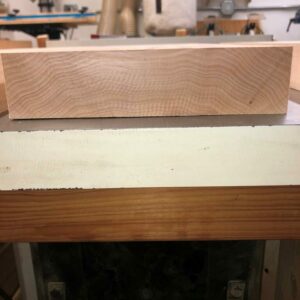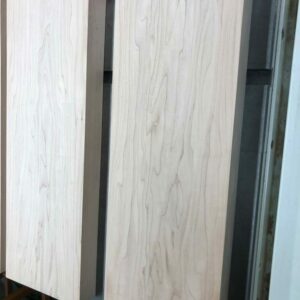My 80-year-old sister would like me to make a 1.5″ thick 20″x20″ edge grain maple cutting board. Yes, I know it will weigh a ton, but if that’s what she wants, that’s what she’ll get. I have an 8′ x 7 1/4″ x 1 11/16″ board which I’ve cut into 21″ long pieces. I’m still a newbie to woodworking, but I believe it is plain sawn (pic #1). I’m planning on jointing and planing the boards down to 1.5″ thick (they’re already almost flat). My question is how best to cut these boards into individual slices to minimize cupping, yet retain as much of the beautiful surface grain pattern as possible (pic #2). My sister likes the John Boos cutting boards and on their website it appears that the individual slices are about 1.75″ wide. To minimize waste, could I cut them 2.25″ wide or would that be too much? Obviously I’ll alternate the grain direction when I glue up the pieces, but I’ve no experience with how much maple will warp over time. To be honest, this will be only the 3rd cutting board I’ve made – the first two were practice ones I made last week. So, any advice would be greatly appreciated.
Discussion Forum
Get It All!
UNLIMITED Membership is like taking a master class in woodworking for less than $10 a month.
Start Your Free TrialCategories
Discussion Forum
Digital Plans Library
Member exclusive! – Plans for everyone – from beginners to experts – right at your fingertips.
Highlights
-
Shape Your Skills
when you sign up for our emails
This site is protected by reCAPTCHA and the Google Privacy Policy and Terms of Service apply. -
 Shop Talk Live Podcast
Shop Talk Live Podcast -
 Our favorite articles and videos
Our favorite articles and videos -
E-Learning Courses from Fine Woodworking
-
-














Replies
BTW, I realize that after jointing and planing, they may be a bit less than 1.5" thick, but that's ok with my sister.
The grain in the second photo is face grain, not edge grain. A more durable board would be made by a rip & flip. Cut them into strips just over 1.5" wide and flip them to get edge grain on the face of the cutting board. You'll get 4 strips out of each length of 7.25" wide board... that's 6" of edge grain from each strip, plenty to get you home. Ust TB-lll or epoxy and it should stay flat and last forever.
If you just glue up the wide strips it won't be as durable or stay as flat.
You're correct, my mistake. I had seen something somewhere that face and edge were essentially the same thing. Doing a bit more digging it looks like with heavy use face grain might show knife marks a bit more readily than edge grain. However, in the case of the boards I have, the face grain is quite a bit more interesting. I may have to ask my sis how much she uses her current cutting board?
Edge grain would be face grain if the log was sawn 90 degrees differently. They are the same thing. Face grain on a typical flat sawn board will vary from pure cathedrals in the middle--the grain you presumably like--to riffsawn toward the edges on the face and on the edge (at that location). Some boards will also show quartersawn on the face toward the edges, and face grain then on the edge--it depends on the width of the boat compared to the log it came from and the location of that board in the stack when cut.
Edge grain and face grain would be what they are however you saw a log. Within a tree there is wood, grain is created by us when we cut a log apart into boards and lay it on the ground. Face grain and edge grain are not the same thing, they are agreed upon terms that allow us to talk about the substance we work with and to help newcomers to the craft like the OP succeed.
Without the common language we are all lost. If I turn a 1x6 on edge do I now have a 5 1/2" thick board that is 3/4" wide? Do we describe a wide quartersawn board as having flatsawn grain edges?
Wood behaves in a predictable way as it relates to grain, which allows us to make decisions as to how and where we use a particular board. If face grain and edge grain were the same thing we would only have "grain", and we would not talk about it so much.
Do you want to build an "end grain" cutting board surface or an "edge grain" cutting board surface? They are not same and I'm wondering if you are confusing the two?
I'm also confused by many remarks above. Face and edge mean the same thing to me. Either can be flat, rift, or quartersawn. End grain is distinctly different.
Definitely not an "end" grain board - have seen enough articles and videos on both types to know the difference (no offense meant).
I should have made my original question shorter because it boils down to this: regardless of face or edge grain, is there any sort of rule of thumb on how wide an individual strip or piece of the cutting board can be? I know the answer is subject to a lot of variables: the direction of the end grain of the piece, the species of wood, whether it was kiln- or air-dried, etc. My guess is a strip over 2" as I suggested is probably pushing the envelope and I should stick with narrower strips and alternate the end grain direction to minimize the inevitable effects of cupping.
2 views, looking at the end grain of a cutting board.
Excellent graphic. As much as I like the look of the face grain of these boards, I have to agree with your original post that rip and flip makes the most sense.
Or, buy quartersawn stock. Rip and flip is just creating quartersawn parts.
I've made them both ways, and also combined edge and face (wider lighter face strips combined with narrow, darker stripes on edge). For me, the most important thing is to make sure you have a good spring joint, i.e., the middle of the glued edge is slightly narrower than the ends (like maybe .002") so that the ends have the tightest seal. You do that with a plane after you have jointed the wood.
As for face grain showing knife marks, hard maple is not likely to have that problem. Also, I recently made a board with cherry edge grain strips and I found some of them didn't like planing and suffered minor tearout. Whichever way you go, try to make sure that the show surface does not have wandering grain that you can't plane well.
Try this YouTube video...Tommy McLaughlin end grain cutting board. It is likely going to be informative.
A little long at 45 minutes but he is calm and to the point, and Mclaughlin his skills are at the top, too.
I basically followed his guidance when making a couple of end grain boards last year.
Mike
https://www.youtube.com/watch?v=gj94YyLyrZ4